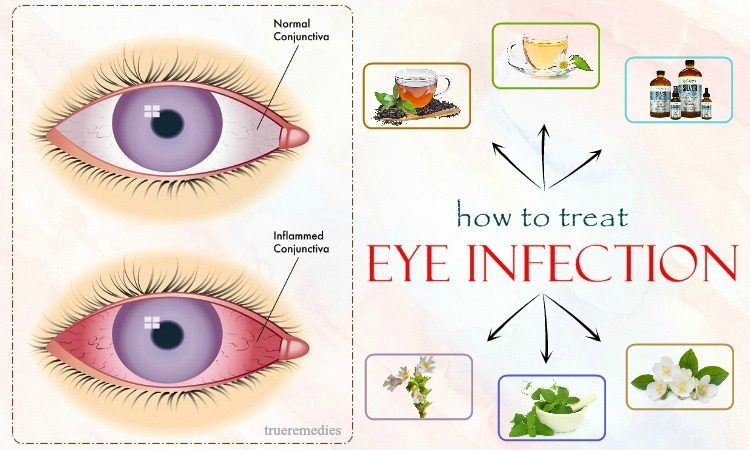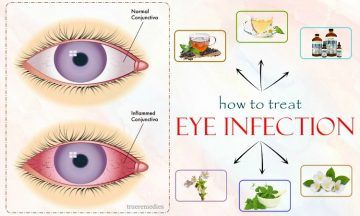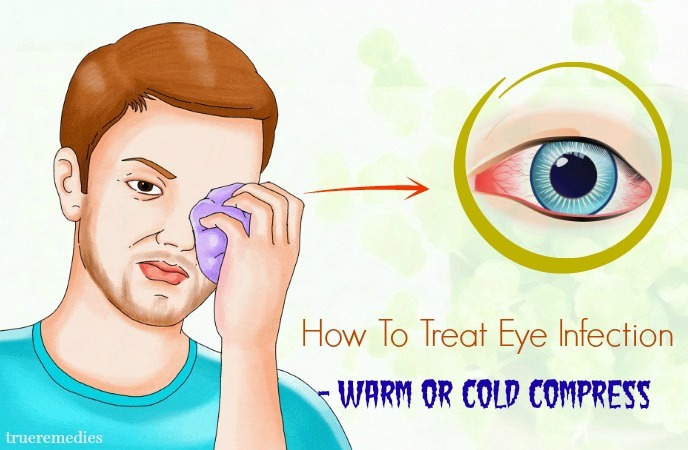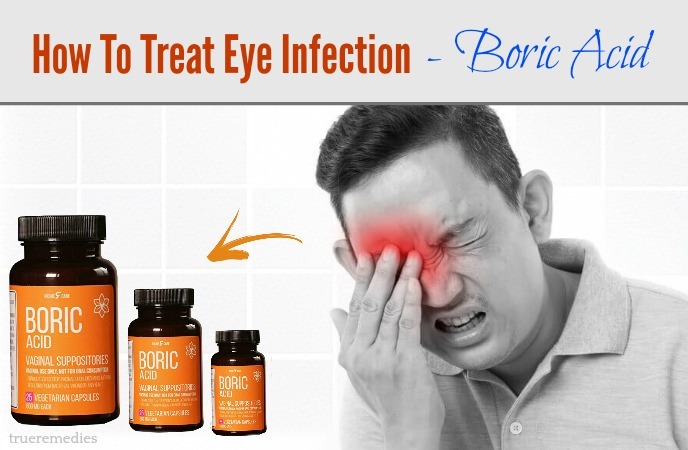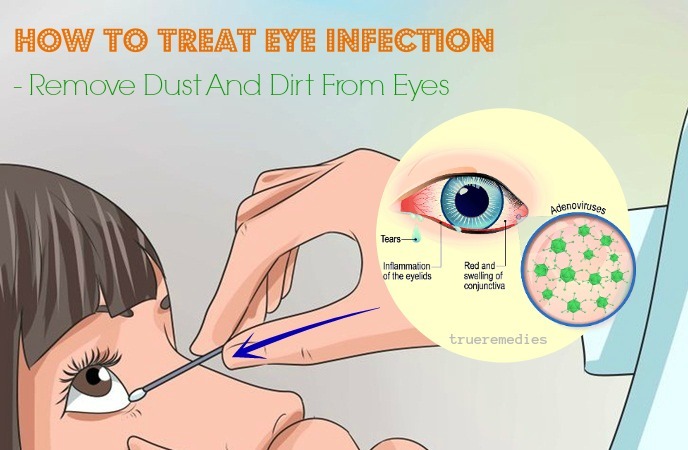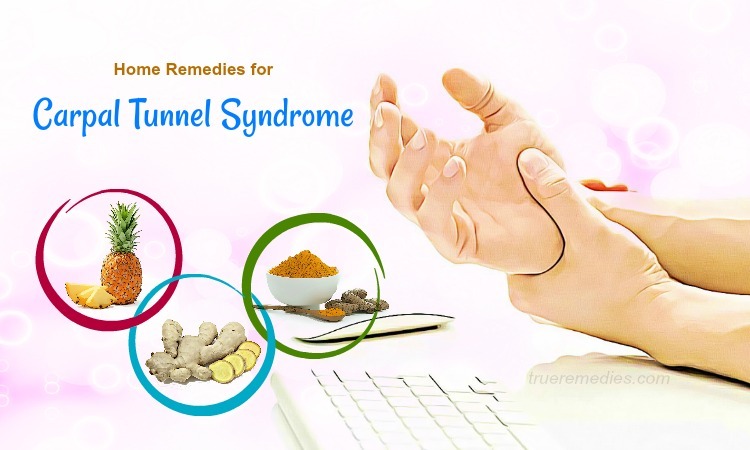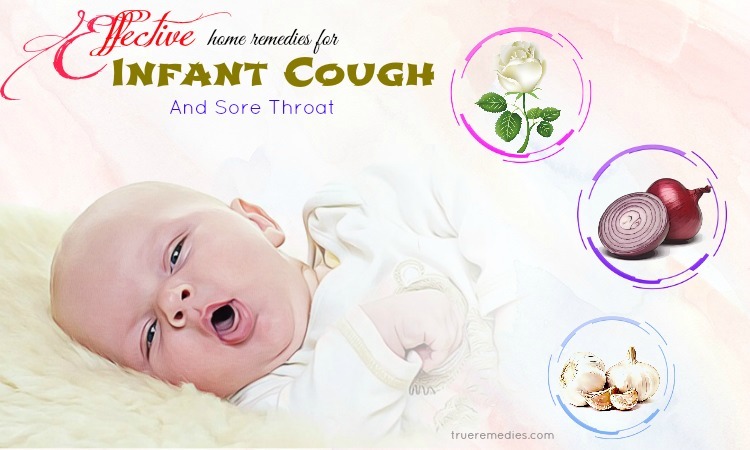Contents
Eyes can be infected by a variety of viruses, fungi and bacteria. Each of the infectious agents causes different symptoms, but typical signs are irritation, pain, redness or inflammation, watery eyes and decreased vision. The agent may cause one or both of the eye infections and can lead to loss of vision or blindness.
The most common eye infections are conjunctivitis and allergic infections. You should see a doctor immediately if you have pain or vision problems. On the other hand, if the infection is mild, you can treat it right at home. This article will give you some tips on how to treat eye infection naturally at home. But first of all, you need to know the information about eye infections below.
What Is Eye Infection?
Eye infections are eye diseases caused by bacteria, viruses or other micro-organisms. These diseases cause your eyes to be red and swollen. The infectious agents can infect any part of the eyeball or surrounding area, including the optic membrane of the eye called cornea, and the thin and damp layers outside the eye and inside the eyelid called conjunctiva. More serious infections in the eye can enter the deeper parts of the eye, causing vision problems such as endophthalmitis. With post-septal cellulitis, the infection is found in and around the soft tissues of the eyelid, which is indicative of an emergency because the condition can be widespread if left untreated.
Eye infections are usually divided into the following specific diseases:
- Conjunctivitis
Conjunctivitis is the most common eye infection. It is an inflammation of the conjunctiva which is the outer layer of the eyeball connecting to the inner surface of the eyelid. It is usually caused by allergies, or by viral or bacterial infections.
- Hordeolum
Hordeolum is caused by staphlococcal bacteria that live on the surface of the skin, leading to the formation of red spots on the eyelids or eyelashes. It usually causes itching or sore eyes.
TrueRemedies Partner Solutions

Need a Help from the Leading Expert Online, Available 24/7?
They’re all here and ready to answer your questions online or by phone. Keep asking questions until you get the answer you need.
- Eyelid Inflammation
Eyelid inflammation is a disease that occurs when the oil glands in the eyelid become obstructed, causing the eyelid to become infected. It can cause itching constantly.
- Corneal Inflammation
Corneal inflammation is a disease of the eye that is associated with bacteria, viruses or parasites that damage the cornea.
Any infection, if not treated promptly and thoroughly, can cause very serious consequences. Eye infection is no exception. The disease can cause loss of vision or blindness in one eye or both eyes. Therefore, as soon as the disease is found, treatment should be performed as soon as possible. It is best to prevent it early. To do this, you need to understand the causes of eye infections.
What Are Common Causes Of Eye Infection?
Here are common causes of this disease:
- The Disease Can Be Transmitted Through The Eyes
One of the common eye infections, conjunctivitis, is easy to spread through the eyes. Therefore, it is very infectious in children in day care centers, classrooms, playground and similar centers. Teachers and day care workers are also at high risk of developing this disease when they work in their workplaces.
- Transmission From Mother To Child
When you get the virus or bacteria through sex, the fetus can also be affected. As a result, babies can also get eye infections because of their mother.
- Herpes Simplex Virus
Unfortunately, some intestinal diseases can also cause eye infections. When exposed to the herpes simplex virus which usually causes symptoms such as blisters in the lips and around the mouth, burns, and itching, you are very susceptible to eye infections.
- Contact Lenses
Improper use of contact lenses can make you susceptible to eye infections. The reason is that contact lenses cleaning before and after use is very important. If you use contact lenses which are not cleaned properly, your eyes will be very vulnerable. Then, eye infection is unavoidable. People wearing contact lenses are at risk of experiencing parasites which can invade the eye and cause a potentially serious infection known as Acanthamoeba dermatitis. That is why people wearing contact lenses should adhere to certain safety tips, such as avoiding swimming while wearing contact lenses. If you wear contact lenses when swimming or relaxing in a hot tub, make sure that you remove and disinfect your lens soon after.
- Fusarium Fungi
Eye infections associated with Fusarium fungi are often found in organic matter. This fungus can enter the eye in different ways, such as through a penetrating wound caused by a tree branch.
- Allergy
Allergy causes the eyes to become very sensitive. Then, they become very vulnerable. Only a small agent such as dust or smoke can cause an eye infection.
- Contact With Chemicals
If you work in a chemical environment, you need to wear eye protection. Chemicals often have a lot of effect on the eye and the treatment is very time consuming.
- Exposure To Strange Objects
Sometimes, when you're on the road, you feel something suddenly fall or fly into your eyes. Then, you need to clean the eyes as soon as possible; otherwise, you are very susceptible to eye infections.
- Eye Injuries
Eye injuries create favorable conditions for viruses and bacteria to enter the eye, causing eye infections.
What Are Common Symptoms Of Eye Infection?
Here are common symptoms of this condition:
- Persistent itching in the eyes
- Eyelids are scaly
- Eyesore
- Always feel very uncomfortable in the eyes
- Blurred vision
- Weep
- Swelling in the eyes, eyelids, and surrounding tissues
- Matter
- Always feel dry eyes
- Eyes become sensitive to light
You may experience other symptoms not mentioned. If you have any questions about the signs of the disease, please consult your doctor.
What Are Risk Factors?
Both children and adults can develop eye infections. However, people who regularly use contact lenses and people who suffer from eye injuries are at higher risk.
Some of other common risk factors of eye infection include:
- Eye injury, especially with plant material like sticks or thorns
- Chronic eye disease related to eye surface
- Eyes being contacted with contaminated medical products
- Fungal bloodstream infection
Besides, people with weakened immune system, diabetes, or use corticosteroids might be prone to suffering from eye infections than other people.
You can control this problem by minimizing risk factors and seeing your doctor for more more information.
When To See A Doctor?
As we mentioned above, for mild eye infections, you can treat your condition yourself with home remedies. However, if symptoms persist after a period of treatment, you should see a doctor.Besides, if you have any questions, please consult your doctor. Each person's condition is different, so please consult your doctor to select the most suitable option.
Above are some basic information about eye infection. Hopefully with this information, you may have the most comprehensive view of this disease. Here are tips that will help you quickly treat eye infection so you will feel more comfortable. Please take a look at TrueRemedies.com!
Top 26 Effective Tips On How To Treat Eye Infection Naturally At Home
1. Warm Or Cold Compress
Warm or cold compress is the first and foremost tip on how to treat eye infection at home. You can try applying cold compress or warm compress (not hot compress) to see which method works better for you. These method also helps prevent red eyes [1]. You should try both ways before making a choice. To do this, please follow these steps below:
- Dip a clean towel into cold water or warm water
- Squeeze towel to remove water
- Apply this towel on the eyes
After about 2-3 minutes, continue doing this tip again. You can do it repeatedly until you feel better. When doing this, lie down and relax. This tip is especially useful if you apply it as soon as you notice the initial signs of an eye infection. You can apply it several times a day whenever you feel uncomfortable in the eyes [2].
2. How To Treat Eye Infection – Use Warm Gauze
This is another must-try treatment in this list of tips on how to treat eye infection at home. Applying a warm gauze over the eyes also helps relax the muscles around the eye and can therefore reduce the eye strain and dry sensation of infected eyes. You can use dry or moist warm gums, depending on how comfortable you feel. If you wear glasses or contact lenses, you must remove them before applying this tip.
If you want to use dry gauze, you can follow the instructions below:
- Pour the rice or bean into a sock and tie it
- Leave it on the microwave for 30 seconds until it warms up(but not too hot)
- Apply it to affected eyes
If you want to use moist gauze, you can follow the instructions at the first tip. You can also use herbal tea bags to replace the moist gauze. Some herbal teas, such as chrysanthemum tea, eyebright, daisy, oregon grape and barberry contain an anti-inflammatory ingredient that can soothe the eyes. Although there is no scientific evidence proving that tea bags are more effective than other types of gauze, you may find the aroma of the herb very pleasant. To use them, you can apply these following steps:
- Put two tea bags into the pan and pour boiling water into it
- Soak tea for 5 minutes or until the water is still warm
- Squeeze two tea bags and apply them to your eyes
- Lean back and relax
Remove the tea bag when it has cooled down completely. You can do it many times if you want.
3. Black Tea
Using tea bags on eyes is a common home remedy. Tea bags might assist you in improving your eye’s appearance by decreasing dark circles, redness and puffiness. They also help with styes, pink eye and irritation.
Tea leaves have antibacterial properties, helping cure eye infection naturally. Using tea will decrease the swelling and redness in the eyes. There are some types of tea that you can use for eye concerns. To get the best results, you should use organic black tea to avoid any chemicals. Black tea has catechins, which are powerful antioxidants, guanine, xanthine and tannins. The polyphenols and antioxidants are associated with many health benefits.
Follow these guidelines:
- Take a tea bag to boil in hot water
- Let it cool down and apply over your affected areas
- Repeat this routine 3-4 times per day till your eye infection go away
Note:
- Always be cautious upon using tea bags on eyes as the eye area is high sensitive.
- Wash your hands and face before treatment
- Avoid using hot tea bags
- Eliminate makeup prior treatment
4. How To Treat Eye Infection – Chamomile Tea
Basically, chamomile flowers are mildly sedative, thereby making them effective for relaxation and improving sleep quality. Furthermore, you can also use chamomile tea in the form of eyewash to relieve symptoms of eye infection. The anti-inflammatory and antimicrobial properties of this herb can soothe inflamed eyes and clear infections. The 2010 study showed that chamomile successfully cleared infections in tear sacs, remove conjunctivitis symptoms and treat some other eye disorders [3] [4] [5].
You can use chamomile tea bags to make a therapeutic eye compress for eye infection relief.
Alternatively, mix honey with chamomile to create a homemade solution for how to treat eye infection. Do as follows:
- Put 2 cups of water into a pan and boil somehow
- Place 2 chamomile tea bags, 2 tablespoons of dried calendula blossoms, 2 tablespoons of crushed fennel seeds into the pan
- Let it steep for 10 minutes
- After it cool down, squeeze the excess liquid from tea bags
- Place tea bags in two cheesecloths and drizzle honey onto each side
To create a poultice, you wrap the gauze or cheesecloth, place onto each of your eyes. Because infections can spread, it is crucial to deal with both eyes. After applying the poultice, relax for 10 minutes. Repeat this routine twice per day.
Note: Some people might be allergic to chamomile. Thus, if you suffer from allergic conjunctivitis, you should avoid using this method.
5. How To Treat Eye Infection – Boric Acid
Boric acid is regarded as an antiseptic in treating mild winds. Its mild nature can help heal infections in the eyes. It could be used as a eye drop to help heal the retina.
6. How To Treat Eye Infection – Jasmine Flowers
Another must-try tip on how to treat eye infection is using jasmine flower. Its medicinal properties can decrease irritation and inflammation resulted
7. How To Treat Eye Infection – Eyebright
One of useful tips on how to treat eye infections naturally at home is using eyebright. Also known as euphrasia, eyebright is a natural herb that has been used for eye infection treatment traditionally. It also protects your eye sight while preventing vision issues.
You can use 3 drops of the eyebright for thrice per day to relieve infections in eyes, in accordance with the Journal of Alternative and Complementary Medicine. Also, thanks to its antimicrobial properties, eyebright has the ability to kill off a variety of bacterial strains which result in eye infections [6].
To achieve the best results, you are recommended to use homeopathy euphrasia eye drops.
8. How To Treat Eye Infection – Colloidal Silver
Regarded as a little-known tip on how to treat eye infection, colloidal silver has a lot of tiny particles of silver which possess antibacterial effects if used on the human skin. The eye drop that has colloidal silver can remove eye infections and prevent conjunctivitis, according to the National Center for Complementary and Integrative Health [7].
- After buying colloidal silver, you pour 1-2 drops into your affected eye
- Blink well to distribute the liquid
- Repeat this routine twice per day until you get good results
- In case there are swelling and itching around your eyes because of mild eye infections, use colloidal silver cream to treat it.
9. Holy Basil
Also known as tulsi, holy basil is renowned for its healing effect. Possessing soothing and anti-inflammatory properties, tulsi can protect your eyes from free radicals and environmental damage. Also, thanks to the power to combat bacterial, viral and fungal infections, holy basil is worth mentioning in this series of tips on how to treat eye infection naturally.
What you need to do is soaking tulsi leaves in the boiled water for about 10 minutes. Then, rinse your eyes with this liquid or use a clean cotton pad to soak into the liquid and use it as a warm compress [8].
10. How To Treat Eye Infection – Take Good Personal Hygiene
If you want to relieve eye infections once and for all, maintain good personal hygiene is a must. Anyone can get eye infections, especially conjunctivitis. Even so, it does not make you feel ashamed. The most important is preventing the disease from spreading and recurring. To do this, you need to do some of the following:
- Wash your hands often with warm water and soap. This step is especially important before touching the face or eyes.
- Do not share makeup cosmetics, face towels or towels with other people.
- Remove cosmetics which have been exposed to infected eyes.
- Wash the blanket and pillow which has come into contact with the face when you have an eye infection.
11. Add Omega-3 Fatty Acids To The Diet
The next one among tips on how to treat eye infection naturally at home is taking advantage of omega-3 fatty acids. Increasing omega-3 fatty acids may help increase the production of sebaceous glands to reduce the symptoms of eye infections. We all know that omega-3 is good for the eyes and brain because it contains a lot of nutrients such as vitamin A, DHA, EPA and Taurine and calcium. As a result, when using omega-3, you will notice that your eyes are not dry and itchy, so you will feel much more comfortable. However, omega-3 does not completely treat eye infections; it only supports the process of treating the disease.
You can add omega-3 to your body through some foods such as salmon, herring, mackerel, cauliflower, cabbage, nuts and tofu. Not only that, you can also use functional foods to ensure your body receives the required amount of omega-3.You need to use them according to the instructions on the label.
Don’t skip: 28 Natural Tips On How To Get Clear Eyes Fast Without Eye Drops
12. How To Treat Eye Infection – Try Over-The-Counter Drugs
Despite this is not a natural tip on how to treat eye infection, it is often still used at home with observation of doctors. Taking an over-the-counter nasal congestion medication or an over-the-counter antihistamine may help reduce the symptoms of allergic eye infections. Your doctor or pharmacist may recommend the use of some over-the-counter drugs such as Lodoxamide ophthalmic.
13. Use Contact Lenses Properly
As we have stressed above, improper use of contact lenses is one of the common causes of eye infections. To avoid this, follow the instructions below:
- Rinse hands with soap and dry hands before wearing contact lenses. Bacteria from daily activities can easily accumulate in your hands all day, so wash your hands thoroughly before fitting or removing contact lenses to prevent eye infections.
- Wash contact lenses according to directions from the manufacturer and doctor's advice. Use a specialized disinfectant solution when washing and preserving contact lenses. Do not reuse used or reconstituted solutions. Never use soluble salts to disinfect contact lenses.
- Store contact lenses in dedicated boxes. Contact lenses should be cleaned with a disinfectant (do not use water), open them and let them dry themselves. Replace the boxes every 3 months.
- Do not sleep while wearing contact lenses. Wearing contact lenses increases the risk of eye infections as well as causing corneal scratches and damage. Also, it is best to remove them at night as they also cause inflammation of the eye.
- Avoid swimming or bathing when wearing contact lenses. Bacteria can reside in water (or in the shower and cause inflammation of the skin or wherever you are exposed to the eye) so you should remove the contact lenses when bathing. If you must wear contact lenses when bathing (such as swimming), wear goggles and disinfect them immediately afterwards.
14. Remove Dust And Dirt From Eyes
No wonder, this is definitely a basic tip on how to treat eye infection at home. Dust is one of the factors that put your eyes at risk for infection. You can remove dirt from your eyes without much effort. Once you know that dust has entered your eyes, blink several times. Blink will allow eyelashes and eyelids to create tears and remove bacteria and dirt from your eyes. If blink cannot help you, you should spread the upper eyelid and lower eyelid and then blink continuously. This action will allow the lower eyelid to remove dust from your eyes.
Similar to dust, if the dust lies on the eyelids or at the touchable area of your eye, you can use a cotton swab to remove it. If you have determined the location of dirt in your eyes or eyelids, you can use a cotton swab to absorb the dust. Dirt will stick to the swab after you swab it. Do not pierce or rub strongly on the dust. This action can put dirt deep inside your eyelids. If the dust does not float out of your eyes when you soak it, try another tip.
15. How To Treat Eye Infection – Wipe Excess Tears
This sounds strange regarding tips on how to treat eye infection at home, but it works. As the dust gets in your eyes, you will have more tears than usual. If this occurs, close your eyes gently and gently wipe the tissue over the eyes. Excessive tears will help you remove dirt in your eyes. Allows your eyes to wet with water and allow tears to wash them. Do not rub your eyes. You should only use tissues to gently absorb excess tears as they flow from the eyes.
16. Check Your Eyes
This is another must-try method on how to treat eye infection naturally at home. Pull the lower eyelid down and slowly look around, looking for anything stuck in the eyelid. Do the same for the upper eyelids, looking for dirt stuck in your eyeball. If you want to check the area below the eyelid, you can place a swab above the eyelid. This method will allow you to look for any dust particles that are trapped in the eyelid. If you are having trouble finding dirt, you can ask your friend to check your eyes for you.
Also read: 28 Tips How To Treat Red Eyes Naturally At Home Without Eye Drop
17. How To Treat Eye Infection – Rinse Eyes
How to treat eye infection at home effectively? Don’t forget rinsing your eyes thoroughly. If blinking or using a cotton swab does not help you remove dirt, then you need to clean your eyes. To remove dust from your eyes, you can use over-the-counter eye drops or pour clean water into your eyes with a cup (you should buy eye drops with a pH of 7.0). Continuously pour water over your eyes while keeping your eyes open for 15 minutes. Even if dirt has already been removed from your eyes, you should continue to do so to clean any residue left in your eyes. You can also use the gentle pressure of the water from a faucet to remove dirt from your eyes, using your hands to keep your eyes open. Use water temperatures between 15°C (60°F) and 37°C (100°F) to maintain optimum eye comfort.
18. Protect Eyes
For long-lasting results of treating eye infection, you need to take eye protection during the treatment. In this stage, your eyes will be extremely sensitive. Therefore, you need:
- Protect your eyes from ultraviolet light or bright light by wearing sunglasses.
- Avoid using contact lenses until your doctor tells you to.
- Avoid touching your eyes and wash your hands immediately after touching the area around your eyes.
- Inform and report to the eye care professional about symptoms that develop or if the pain is beyond your tolerance.
- If you feel itchy or uncomfortable getting worse, you should see a doctor.
19. Do Not Perform Actions That Make Matters Worse
In many cases, your eyes may be exposed to injuries. There are many actions that you should avoid while dealing with eye problems. They can cause serious eye injury or serious eye pain. These actions include:
- Remove any piece of metal that is trapped in your eyes at home, whether it is large or small.
- Apply a force to the eye to try to remove dirt.
- Use tweezers, toothpicks, or other hard objects to remove dirt. If your eyes are affected by something more serious than dirt, you should seek medical help. Never use these methods to remove acid or other abrasive liquid from the eyes.
20. How To Treat Eye Infection – Regularly Relax Your Eyes
This is another must-try treatment in this list of tips on how to treat eye infection at home. During the treatment of eye infections, keep your eyes relaxed several times a day according to the 20-20-20 rule: every 20 minutes, you let your eyes rest by looking at something at least 6 m away for at least 20 seconds. Focusing on the computer screen for a long time without resting eyes can cause eye pain, headaches and even muscle pain. This only exacerbates the symptoms of an eye infection.
21. Drink A Lot Of Water
Not drinking enough water can make the eyes feel dry, itchy and aching. If you are dehydrated, you cannot produce enough tears to keep your eyes moist. This makes you susceptible to eye infections. Every day, men should drink at least 13 glasses of water (3 liters) and women should drink at least 9 cups of water (2.2 liters).
22. Remove Your Eye Make-Up
Removing your eye make-up is an essential step to know how to treat eye infection at home. Cosmetics can clog the sebaceous glands on the skin, cause irritation and even inflammation. Therefore, always make sure that you completely remove the make-up on your face before going to bed in the evening. You can use a baby shampoo or a special make-up remover for the eyes. Most importantly, make sure you clean your cosmetics every day. If you are in the process of treating an eye infection, you should not apply makeup.
23. Choose Cosmetics That Do Not Irritate The Eyes
This requires trial and error. Even products labeled “hypoallergenic” may still cause eye irritation. You should try a small amount of different types of cosmetics for sensitive eyes to find the one that works best for you. If you still have eye problems with cosmetics, you should talk to your dermatologist. Your doctor may recommend cosmetic products that will not irritate your eyes.
24. How To Treat Eye Infection – Make Good Habits When You Work
Making good working habits will help you walk a long way in protecting your healthy eyes. Proper posture at work can help prevent eye problems, including eye infection. Bending down to the computer desk can not only strain your eyes but also cause eye pain and fatigue. Sit at least 50 – 60 cm away from the computer screen. Place the computer at a moderate height so that you do not have to stoop or lift your eyes. Use a computer screen filter and change the lighting in the office if possible. Older fluorescents emitting flickering may cause eye strain and headaches. Compact fluorescent bulbs (CFL) are the solution to this problem. Keep in mind that you need to improve your eye health to prevent or treat eye infections.
25. Do Not Smoke Or Use Other Irritants
This is the last remedy in this list of tips on how to treat eye infection at home. If your eyes become infected, they may be reacting to something in the environment. Common allergens include cigarette smoke, smog and pet hair. Therefore, you need to limit your eye contact with these agents if you do not want to make your condition worse.
26. Use OTC Eye Drops
Although over-the-counter eye drops do not help treat eye infections, they can reduce redness and irritation. Use eye drops to soothe the eyes as often as directed. To use eye drops most effectively, follow the steps below:
- Wash hands before and after touching the area around the eyes
- Lie on your back before applying eye drops
- Drip drops into the infected eyes
- Close your eyes immediately for about 2-3 minutes
If you use eye drops as soon as you notice signs of an eye infection, you can treat this condition. It is important to follow the recommended dosage on the eye drops label.
Do not be dependent on eye drops. If you use eye drops regularly, you should make sure it does not contain pharmaceuticals or preservatives. Overdose of eye drops containing pharmaceuticals or preservatives may actually exacerbate eye problems.
How To Treat Eye Infection – Preventative Measures
- If you are living close to a personal with eye infections, you should avoid touching your eyes until you wash your hands carefully. Minimize the risk of catching common viral or bacterial infections by using anti-infective cleanser and sprays liberally in the public areas like classrooms or day care centers.
- Use proper eye hygiene.
- When treating eye infections, remember to wash your hands before and after using the remedies.
- Avoid sharing face cloths, pillows or towels
- Protect your eyes with goggles or eyeglasses from chemicals, dust and other irritants.
- If you wear contact lenses, remove them before bedtime.
The aforementioned tips are easy and simple to treat eye infections at home. As we stressed at the beginning, eye infections, if not treated promptly, can cause serious consequences. Therefore, do not disregard the simple above treatments. If you have any contributing ideas about our article of “Top 26 Tips On How To Treat Eye Infection At Home” introduced in How To Category, do not hesitate to drop your words below this post. We will answer as soon as we could.

